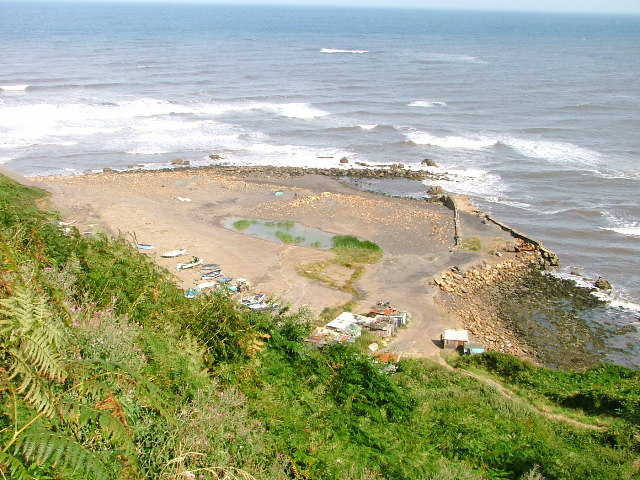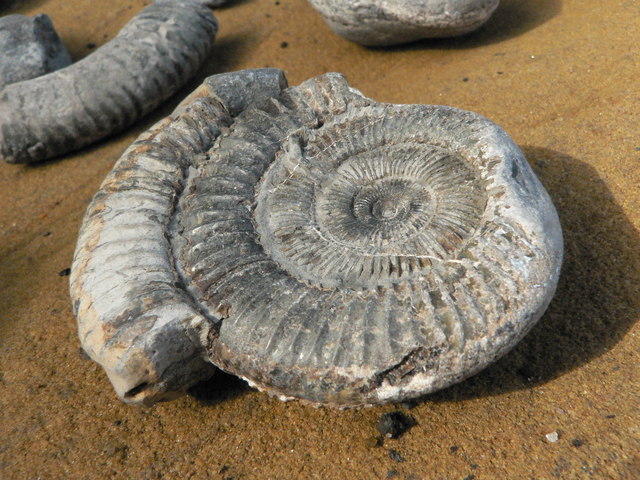Port Mulgrave, North Yorkshire on:
[Wikipedia]
[Google]
[Amazon]
Port Mulgrave is a derelict former
 A nearby harbour was constructed by Sir Charles Palmer in 1856-57 at a cost of £45,000.
Initially the harbour exported ironstone to Jarrow on Tyneside to supply
A nearby harbour was constructed by Sir Charles Palmer in 1856-57 at a cost of £45,000.
Initially the harbour exported ironstone to Jarrow on Tyneside to supply
 The geology of the cliffs is
The geology of the cliffs is
East Cleveland Image Archivepage 2
* Hidden Teesside
Port Mulgrave Ironstone MineGrinkle Ironstone Mine
* Explorer sites
28dayslaterOblivion State
{{Navboxes , list1 = {{Geographic location , Northwest =
ironstone
Ironstone is a sedimentary rock, either deposited directly as a ferruginous sediment or created by chemical replacement, that contains a substantial proportion of an iron ore compound from which iron (Fe) can be smelted commercially. Not to be con ...
exporting port on the North Yorkshire
North Yorkshire is the largest ceremonial counties of England, ceremonial county (lieutenancy area) in England, covering an area of . Around 40% of the county is covered by National parks of the United Kingdom, national parks, including most of ...
coast midway between Staithes
Staithes is a seaside village in the borough of Scarborough in North Yorkshire, England. Easington and Roxby Becks, two brooks that run into Staithes Beck, form the border between the Borough of Scarborough and Redcar and Cleveland. The area l ...
and Runswick Bay
Runswick Bay is a bay in the Scarborough Borough of North Yorkshire, England. It is also the name of a village located on the western edge of the bay (although the village is sometimes shortened to Runswick on UK road signs). It is north of ...
in the civil parish of Hinderwell
Hinderwell is a village and civil parish in the Scarborough (borough), Scarborough district of North Yorkshire, England which lies within the North York Moors National Park, about a mile from the coast on the A174 road between the towns of Loft ...
.
Rows of domestic properties and individual houses exist on the top of the cliff.
Historically the locality was known as Rosedale, but to avoid confusion with the ironstone mines and iron works at Rosedale in the middle of the North York Moors the area was renamed Port Mulgrave for the local landowner the Earl of Mulgrave
The title Earl of Mulgrave has been created twice. The first time as a title in the Peerage of England and the second time as a Peerage of the United Kingdom.
The first creation was in the Peerage of England in 1626 for Edmund Sheffield, 3r ...
.
History
In the 1850s Sir Charles Palmer opened anironstone
Ironstone is a sedimentary rock, either deposited directly as a ferruginous sediment or created by chemical replacement, that contains a substantial proportion of an iron ore compound from which iron (Fe) can be smelted commercially. Not to be con ...
mine at Rosedale Wyke, Port Mulgrave with ironstone loaded onto small vessels from a wooden jetty.
The barges were moved in and out using a paddle steamer
A paddle steamer is a steamship or steamboat powered by a steam engine that drives paddle wheels to propel the craft through the water. In antiquity, paddle wheelers followed the development of poles, oars and sails, where the first uses we ...
.
 A nearby harbour was constructed by Sir Charles Palmer in 1856-57 at a cost of £45,000.
Initially the harbour exported ironstone to Jarrow on Tyneside to supply
A nearby harbour was constructed by Sir Charles Palmer in 1856-57 at a cost of £45,000.
Initially the harbour exported ironstone to Jarrow on Tyneside to supply Palmers Shipbuilding and Iron Company Limited
Palmers Shipbuilding and Iron Company Limited, often referred to simply as "Palmers", was a United Kingdom of Great Britain and Ireland, British shipbuilder, shipbuilding company. The Company was based in Jarrow, County Durham, in north-eastern ...
founded by Sir Charles Palmer.
Later ironstone was sent to blast furnaces by the River Tees.
When the mine at Rosedale Wyke began to run out Sir Charles Palmer established Grinkle ironstone mine to the east near the hamlet of Dalehouse and in 1875 a narrow-gauge railway line was built to the mine.
The ironstone wagons from Grinkle Mine were taken over bridges then through a tunnel under Ridge Lane
down a mile long inclined tunnel on a cable railway
Cable may refer to:
Mechanical
* Nautical cable, an assembly of three or more ropes woven against the weave of the ropes, rendering it virtually waterproof
* Wire rope, a type of rope that consists of several strands of metal wire laid into a he ...
powered by a stationary steam engine situated by the east pier then emerging in the cliff side 30 ft above sea level.
The railway wagons were then led onto a gantry with bunkers on the east harbour wall ready for loading the ironstone directly into ships in the harbour.
The tunnel entrance at the harbour can still be seen but it is sealed up.
In 1911 the pier gantry and boiler house were damaged by a serious fire however, the damage was repaired.
In 1916 Grinkle Mine was connected to the Whitby, Redcar and Middlesbrough Union Railway
The Whitby, Redcar and Middlesbrough Union Railway (WRMU), the Whitby–Loftus Line, was a railway line in North Yorkshire, England, built between 1871 and 1886, running from Loftus on the Yorkshire coast to the Esk at Whitby, and connecting ...
thus avoiding the wartime hazards of shipping and the tramway tunnel abandoned.
Port Mulgrave was a busy port for 40 years but the harbour was redundant by 1920 due to the railway link and cheaper foreign sources of ironstone becoming available.
After falling into disuse the harbour was left to decay.
In 1934 Grinkle Mine was abandoned, then the harbour machinery was sold off as scrap and the gantry accidentally destroyed by a fire.
The west harbour breakwater wall was deliberately destroyed by the Royal Engineers to prevent its use as part of any German invasion during World War II
World War II or the Second World War, often abbreviated as WWII or WW2, was a world war that lasted from 1939 to 1945. It involved the vast majority of the world's countries—including all of the great powers—forming two opposing ...
.
Geography
 The geology of the cliffs is
The geology of the cliffs is Whitby Mudstone Formation
The Whitby Mudstone is a Toarcian (Early Jurassic; ''Falciferum''-''Bifrons'' in regional chronostratigraphy) geological formation in Yorkshire and Worcestershire, England.Cleveland Ironstone Formation
The Cleveland Ironstone Formation is a sequence of marine ironstone seams interbedded with shale and siltstone units which collectively form a part of the Lower Jurassic System of rocks underlying Cleveland in North Yorkshire. Exploitation of ...
}
with traces of Jet in the shale.
The official access route to the beach is down a steep path leading to a wooden ladder.
The cliff area is subject to coastal erosion
Coastal erosion is the loss or displacement of land, or the long-term removal of sediment and rocks along the coastline due to the action of waves, currents, tides, wind-driven water, waterborne ice, or other impacts of storms. The landwa ...
, landslips and path closures, and the tide can cut off beach walkers.
Ammonite, dinosaur
Dinosaurs are a diverse group of reptiles of the clade Dinosauria. They first appeared during the Triassic period, between 243 and 233.23 million years ago (mya), although the exact origin and timing of the evolution of dinosaurs is t ...
and reptile fossil
A fossil (from Classical Latin , ) is any preserved remains, impression, or trace of any once-living thing from a past geological age. Examples include bones, shells, exoskeletons, stone imprints of animals or microbes, objects preserved ...
s can be found on the foreshore and in the cliffs and because of this it is a Site of Special Scientific Interest.
However, digging fossils out of the crumbling cliffs and scree
Scree is a collection of broken rock fragments at the base of a cliff or other steep rocky mass that has accumulated through periodic rockfall. Landforms associated with these materials are often called talus deposits. Talus deposits typically ...
s is dangerous.
The beach is composed of rock, sand and stones.
The Cleveland Way
The Cleveland Way is a National Trail in the historic area of Cleveland in North Yorkshire, northern England. It runs between Helmsley and the Brigg at Filey, skirting the North York Moors National Park.
History
Development of the Clevela ...
walking route passes along the top of the cliff.
Economy
Some inshore fishing using cobles takes place from the harbour. Fishing cabins made fromflotsam
In maritime law, flotsam'','' jetsam'','' lagan'','' and derelict are specific kinds of shipwreck. The words have specific nautical meanings, with legal consequences in the law of admiralty and marine salvage. A shipwreck is defined as the rema ...
and found materials can be seen by the cliffs next to the harbour.
See also
* Grinkle MineReferences
External links
East Cleveland Image Archive
* Hidden Teesside
Port Mulgrave Ironstone Mine
* Explorer sites
28dayslater
{{Navboxes , list1 = {{Geographic location , Northwest =
Staithes
Staithes is a seaside village in the borough of Scarborough in North Yorkshire, England. Easington and Roxby Becks, two brooks that run into Staithes Beck, form the border between the Borough of Scarborough and Redcar and Cleveland. The area l ...
, North = ''North Sea
The North Sea lies between Great Britain, Norway, Denmark, Germany, the Netherlands and Belgium. An epeiric sea, epeiric sea on the European continental shelf, it connects to the Atlantic Ocean through the English Channel in the south and the ...
''
, Northeast = ''North Sea
The North Sea lies between Great Britain, Norway, Denmark, Germany, the Netherlands and Belgium. An epeiric sea, epeiric sea on the European continental shelf, it connects to the Atlantic Ocean through the English Channel in the south and the ...
''
, West =
, Centre = Port Mulgrave
, East =
, Southwest = Hinderwell
Hinderwell is a village and civil parish in the Scarborough (borough), Scarborough district of North Yorkshire, England which lies within the North York Moors National Park, about a mile from the coast on the A174 road between the towns of Loft ...
, South =
, Southeast = Runswick Bay
Runswick Bay is a bay in the Scarborough Borough of North Yorkshire, England. It is also the name of a village located on the western edge of the bay (although the village is sometimes shortened to Runswick on UK road signs). It is north of ...
{{Coastal settlements
, place = North Yorkshire
, settlement = Port Mulgrave
, anticlockwise = Staithes
Staithes is a seaside village in the borough of Scarborough in North Yorkshire, England. Easington and Roxby Becks, two brooks that run into Staithes Beck, form the border between the Borough of Scarborough and Redcar and Cleveland. The area l ...
, clockwise = Runswick Bay
Runswick Bay is a bay in the Scarborough Borough of North Yorkshire, England. It is also the name of a village located on the western edge of the bay (although the village is sometimes shortened to Runswick on UK road signs). It is north of ...
{{The Yorkshire coast
{{North Yorkshire
Populated coastal places in North Yorkshire